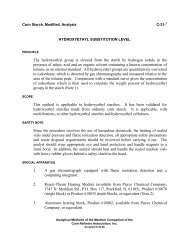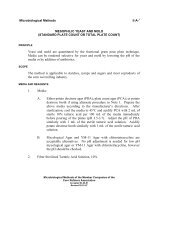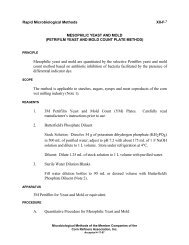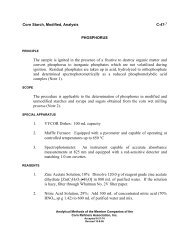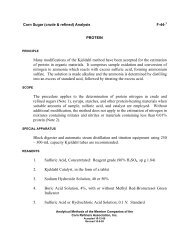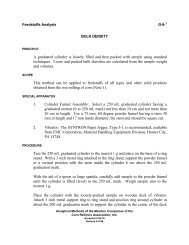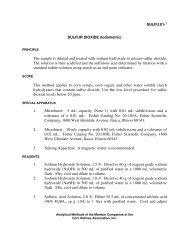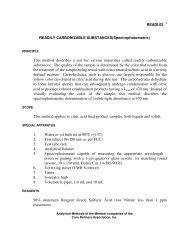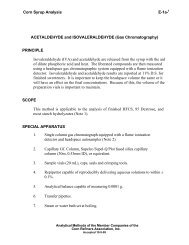pH is a measure of active acidity or alkalinity of solutions as ...
pH is a measure of active acidity or alkalinity of solutions as ...
pH is a measure of active acidity or alkalinity of solutions as ...
Create successful ePaper yourself
Turn your PDF publications into a flip-book with our unique Google optimized e-Paper software.
C<strong>or</strong>n Starch Analys<strong>is</strong> B-44- 1<strong>pH</strong> (Slurry)PRINCIPLE<strong>pH</strong> <strong>is</strong> a <strong>me<strong>as</strong>ure</strong> <strong>of</strong> <strong>active</strong> <strong>acidity</strong> <strong>or</strong> <strong>alkalinity</strong> <strong>of</strong> <strong>solutions</strong> <strong>as</strong> contr<strong>as</strong>ted with thetitratable <strong>acidity</strong> <strong>or</strong> <strong>alkalinity</strong>. The <strong>pH</strong> value <strong>of</strong> a sample solution <strong>or</strong> d<strong>is</strong>persion <strong>is</strong>determined by me<strong>as</strong>uring the potential difference between two immersedelectrodes.SCOPETh<strong>is</strong> procedure <strong>is</strong> generally applicable to modified and unmodified starches whichare substantially insoluble in water at room temperature.SPECIAL APPARATUSREAGENTSPROCEDURE1. <strong>pH</strong> Meter: A modern instrument with both <strong>pH</strong> and millivolt (mV) readouts,equipped with gl<strong>as</strong>s and reference electrodes, capable <strong>of</strong> me<strong>as</strong>uring <strong>pH</strong>values in the range <strong>of</strong> 1 to 10 (accurate to 0.01 <strong>pH</strong> unit), <strong>is</strong> recommended.Sat<strong>is</strong>fact<strong>or</strong>y instruments and electrodes are available from several suppliers.2. Stirring Apparatus: A magnetic stirrer <strong>is</strong> usually preferred. Connect thech<strong>as</strong>s<strong>is</strong> <strong>of</strong> the stirrer electrically to the ground circuit <strong>of</strong> the <strong>pH</strong> meter. Anadditional ground between the starch slurry and the <strong>pH</strong> meter ground circuitmay be necessary to minimize erratic readings caused by rapid stirring.Standard Buffers: Two buffer <strong>solutions</strong>, having known <strong>pH</strong> values <strong>of</strong> about 4 and7, are necessary (Note 1).Standardization (Note 2):Follow the manufacturer's instructions in preparing the meter f<strong>or</strong> <strong>pH</strong><strong>me<strong>as</strong>ure</strong>ments. Connect to a power source with a ground, and connect sh<strong>or</strong>tingstrap to meter. Switch meter to mV mode; a reading <strong>of</strong> 0 mV should be observed.Analytical Methods <strong>of</strong> the Member Companies <strong>of</strong> theC<strong>or</strong>n Refiners Association, Inc.Accepted 11-26-56Rev<strong>is</strong>ed 10-10-85
C<strong>or</strong>n Starch Analys<strong>is</strong> B-44- 2<strong>pH</strong> (Slurry) ⎯ continued(If the meter h<strong>as</strong> no mV mode, it should read 7.00 + 0.05 <strong>pH</strong>.) Zero theinstrument (mV = 0 <strong>or</strong> <strong>pH</strong> = 7.0) by adjusting the meter movement.Plug prepared (hydrated) <strong>pH</strong> electrodes into the instrument. Rinse with purifiedwater, and remove excess by blotting with clean, dry t<strong>is</strong>sue (do not wipe!). Placeelectrode probe in "fresh" standard buffer having a known <strong>pH</strong> value <strong>of</strong> about 7.0,and stir at a rate sufficient to produce a small v<strong>or</strong>tex at the solution surface.Switch meter to mV mode; observe and rec<strong>or</strong>d the mV reading after a steadyresponse <strong>is</strong> obtained.Switch meter to the <strong>pH</strong> mode and adjust the meter to read the stated <strong>pH</strong> value <strong>of</strong>the standard buffer by moving the "ZERO" <strong>or</strong> "CALIBRATE" knob, after a steadyresponse <strong>is</strong> obtained.Remove electrode probe from the <strong>pH</strong> 7 buffer, rinse with purified water, andremove excess by blotting with a clean, dry t<strong>is</strong>sue. Place the electrode probe inthe second standard buffer having a known <strong>pH</strong> value <strong>of</strong> about 4.0, and stir <strong>as</strong>bef<strong>or</strong>e. Switch meter to mV mode; observe and rec<strong>or</strong>d the mV response after thereading h<strong>as</strong> stabilized.Calculate meter sensitivity <strong>as</strong> follows:mV per <strong>pH</strong>=<strong>pH</strong> 4.0 Buffer mV - <strong>pH</strong> 7.0 Buffer mV<strong>pH</strong> 4.0 - <strong>pH</strong> 7.0Meter sensitivity should equal 59 + 3 mV per <strong>pH</strong> unit. If not, refer to themanufacturer's instruction manual.When sensitivity <strong>is</strong> sat<strong>is</strong>fact<strong>or</strong>y, switch meter to <strong>pH</strong> mode and adjust theinstrument to read the stated <strong>pH</strong> value <strong>of</strong> the second standard buffer by moving the"SLOPE" <strong>or</strong> "TEMPERATURE" knob. If the meter does not have the mVme<strong>as</strong>uring mode, d<strong>is</strong>regard the mV <strong>me<strong>as</strong>ure</strong>ments and the sensitivity calculation,and adjust the instrument to read the stated <strong>pH</strong> value <strong>of</strong> the second standard bufferby moving the "SLOPE" <strong>or</strong> "TEMPERATURE" knob.
C<strong>or</strong>n Starch Analys<strong>is</strong> B-44- 3<strong>pH</strong> (Slurry) ⎯ continuedRemove electrodes from the second standard buffer, rinse with purified water, andremove the excess by blotting with a clean and dry t<strong>is</strong>sue pri<strong>or</strong> to sample analys<strong>is</strong>.St<strong>or</strong>e electrodes in fresh <strong>pH</strong> 4 buffer when not in use. Do not st<strong>or</strong>e in water!Analys<strong>is</strong>:Starch samples containing hard granular particles should be ground. In mostc<strong>as</strong>es, however, grinding <strong>is</strong> not necessary.Weigh 20 g (+ 0.1 g) <strong>of</strong> sample, transfer to a gl<strong>as</strong>s beaker and add 100 mL <strong>of</strong>purified water at room temperature (about 25 °C). Stir about 5 minutes (Note 3) ata rate sufficient to produce a small v<strong>or</strong>tex at the slurry surface and to d<strong>is</strong>perse thesample completely. Observe and rec<strong>or</strong>d the <strong>pH</strong> value to the nearest 0.1 <strong>pH</strong> unit,after a stable reading <strong>is</strong> achieved. If erratic and/<strong>or</strong> unstable readings are observed,refer to the manufacturer's instruction manual.NOTES AND PRECAUTIONS1. Both liquid and dry stock buffers are available commercially, and can beused with confidence when handled acc<strong>or</strong>ding to the manufacturer'sinstructions.2. The meter and electrodes should be standardized daily in both the <strong>pH</strong> andmV modes to <strong>as</strong>sure accurate <strong>me<strong>as</strong>ure</strong>ments.3. Starches containing additives may require longer than 5 minutes to reach <strong>as</strong>table <strong>pH</strong> reading. Stir until a steady <strong>pH</strong> reading <strong>is</strong> observed (<strong>as</strong> much <strong>as</strong>30 minutes may be required with some samples).



